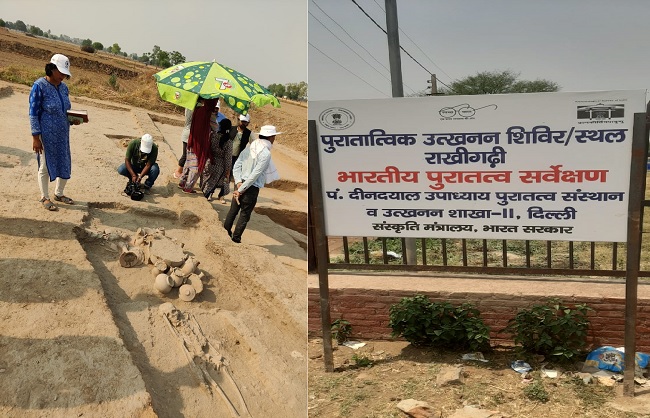Rakhigarhi, May 8: Now Rakhigarhi has also been included in the five major Harappan sites of the country. Smart cities of 7000 years old Harappan era have been found here.
In the excavations done by the Archaeological Survey of India (ASI), it has been found that even 7000 years ago, people used to build houses in a planned manner. The drainage system was better in the settlements. There were lanes joining the streets. The bricks were strengthened by burning raw clay at the bends of the roads so that the construction at the bend would not be damaged. In the excavation of Rakhigarhi, seals, pottery and ivory, gold, human bone objects and clay toys have been found.
Dr Sanjay Manjul, Joint Director General, Archaeological Survey of India (ASI) said that Rakhigarhi has immense potential. In this area spread over 350 hectares, many secrets have been revealed about the life of 7000 years ago. Many evidences have been found in the excavation of the land, from which information has been received about the city planning, living habits, work and business of that time.
He told that there are many secrets buried in the historical site, so excavation will be done here again in September.
Ajay Yadav, Additional Director General of the ASI said that on the basis of the remains found in the excavation till now in the mound number, antiquities and evidence have been found from the Early Harappan period to the Mature Harappan period. The settlements here were located near the Drishti, one of the tributaries of the Vedic Saraswati, which is recognized as the modern Chautang River. Among the remains found here, evidences have been found for dyeing clothes, artifacts in Kumbhakari works, making pottery, beads made of precious stone. To know more about this city, more excavation is to be done here so that the picture can be completely clear and a wonderful and planned city can be brought to the fore.
Where is rakhigarhi
The archaeological site of Rakhigarhi is 57 km from Hisar city and 150 km north-west of New Delhi in Narnaud tehsil in district Hisar, Haryana. The archaeological evidence of the site covering the present villages of Rakhikhas and Rakhishahpur and its surrounding agricultural areas is approx. It is spread over 350 hectares. There are total 11 mounds in Rakhigarhi.
When did the excavation happen?
This site was first discovered by Professor Suraj Bhan in the year 1969. After that, in the year 1997-2001, excavation work was done here by the Archaeological Institute, ASI. After that from 2013 to 2016 researchers from Deccan College, Pune excavated here.
Will be developed like an iconic site
According to the Union Budget for the year 2020-21, the Government of India had planned to develop five iconic sites as Iconic Sites. One of them is Rakhigarhi. Its purpose is to highlight the structural remains along with providing facilities to the visitors to the archaeological site of Rakhigarhi. Along with this, by preserving the remains here in the future, it is also to be made accessible to the people. A Memorandum of Understanding (MoU) is underway between the Archaeological Survey of India and the Government of Haryana, according to which the antiquities of Rakhigarhi will be displayed in a museum set up by the Haryana Government.
This time the excavation took place on three mounds
This time three mounds have been taken for excavation. In this, Tila-one, Tila-three and Tila-seven have been taken for investigation. A total of 13 trenches have been made in three mounds. Tila- one has five moats, mound- has seven moats and mound- seven has one moat.
What was found in which mound
mound-one
Among other activities at Tila-one a large amount of waste of semi-precious stones has been found which was widely used for the manufacture of objects such as pearls.
According to the remains found, evidence of a road has been found with a normal width of 2.6 meters. There are two clay bricks on either side of this road which proves that it has been made systematically. Its lanes run for 18 meters in east-west and north-south direction. Presently 15 parts of clay bricks are visible.
mound three
Tila- one located in the south-west direction from the mound- three is being excavated, where a burnt brick wall has been found, which is in the east-west direction. At present an open wall of 11 m length, 58 cm width and 18 brick height has been found for the visitors. This burnt-brick has been found in combination with clay-bricks. A drain made of bricks has been found adjacent to this wall in the southern part of the wall.
Tila one and mound three include seals, elephants and uncooked terracotta objects belonging to the Harappan script. Statues of animals like dogs, bulls, etc. made of terracotta and steatite, a large number of steatite beads, semi-precious stone beads, copper objects etc. have also been found in the excavations.
mound – seven
Tila-seven which is located 500 meters north of Tila-one. In the last excavation, about 60 tombs were found here. This time two graves have been found in the excavation of this area. These graves have been identified to be of two women. Women are buried with pottery and decorated ornaments and shell bangles. Beads are used in jewellery. A small copper mirror has been found with a skeleton. The skeletons are believed to be 5000 years old. But the ASI has sent a sample to get their DNA done, so that they can get the correct information about their old age.





